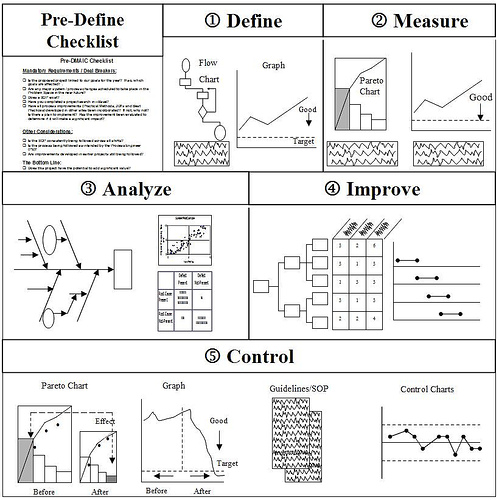Six Sigma is a business improvement methodology that was developed at Motorola to systematically reduce or eliminate defects and reduce variation. Six Sigma typically follows the Define, Measure, Analyze, Improve, or Control framework (DMAIC), sometimes referred to as DMAIC Framework Six Sigma. Six Sigma also has the Define, Measure, Analyze, Design, and Verify framework (DMADV), for product design, or redesigning an existing process.
Below is the DMAIC Framework Storyboard, followed by an explanation of each Phase:

Define
The first phase is Define. During the Define phase, a team and its sponsors reach agreement on what the project is and what it should accomplish. Presuming that a draft of the Project Charter is already in place, the main work in the Define phase is for the project team to complete an analysis of what the project should accomplish and confirm understanding with the sponsor(s). They should agree on the problem, which customers are affected, and how the current process or outcomes fail to meet their customers’ needs through “Voice of the Customer or Critical-To-Quality (CTQ).”
Measure
One of the major benefits of Six Sigma is its demand for a fact-based and data-driven analytical approach. Most other improvement methodologies, including Lean, tend to attempt process improvement without sufficient data to understand the underlying causes of the problem. The result is typically many quick-hit projects with short-lived or disappointing results. Combining data with knowledge and experience is what separates true improvement from mere process tinkering. One of the goals of the Measure phase is to pin-point the location or source of a problem as precisely as possible by building a factual understanding of existing process conditions. That knowledge helps you narrow the range of potential causes requiring investigation in the Analyze phase. An important part of Measure is to establish a baseline capability level.
Analyze
The Measure phase has identified the baseline performance of the process. By stratifying (sequenced in order of ranks or order) the data in the baseline performance, it becomes possible to pinpoint the location or source of problems by building a factual understanding of existing process conditions and problems. That helps to focus the problem statement. In the Analyze phase you will develop theories of root causes, confirm the theories with data, and finally identify the root cause(s) of the problem. The verified cause(s) will then form the basis for solutions in the Improve phase.
Improve
The sole purpose of the Improve phase is to demonstrate, with fact and data, that your solutions solve the problem. Your organization will make changes in a process that will eliminate the defects, waste, and unnecessary costs that are linked to the customer need identified during the Define phase. Tools and strategies you will find for the Improve phase will include solution matrices that link brainstormed solution alternatives to customer needs and the project purpose, and methods for implementing desired solutions.
Control
During the Improve phase, the solution is piloted, and plans are made for full scale implementation. Putting a solution in place can fix a problem for the moment, but the activities in the Control phase are designed to insure that the problem does not reoccur and that the new processes can be further improved over time.
Project Ideas
What kind of projects can you perform using DMAIC? Here is a list of improvement project examples by industry and department
[contentblock id=16 img=gcb.png]









Comments are disabled for this post.